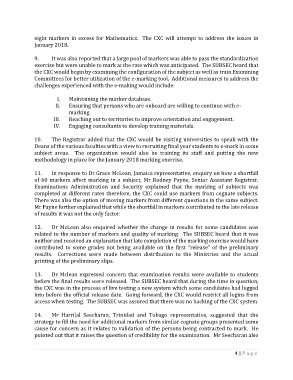Page 286 - SEC_2017WorkingDocument_Neat
P. 286
eight markers in excess for Mathematics. The CXC will attempt to address the issues in
January 2018.
9. It was also reported that a large pool of markers was able to pass the standardization
exercise but were unable to mark at the rate which was anticipated. The SUBSEC heard that
the CXC would begin by examining the configuration of the subject as well as train Examining
Committees for better utilization of the e-marking tool. Additional measures to address the
challenges experienced with the e-making would include:
I. Maintaining the marker database.
II. Ensuring that persons who are onboard are willing to continue with e-
marking.
III. Reaching out to territories to improve orientation and engagement.
IV. Engaging consultants to develop training materials.
10. The Registrar added that the CXC would be visiting universities to speak with the
Deans of the various faculties with a view to recruiting final year students to e-mark in some
subject areas. The organization would also be training its staff and putting the new
methodology in place for the January 2018 marking exercise.
11. In response to Dr Grace McLean, Jamaica representative, enquiry on how a shortfall
of 60 markers affect marking in a subject, Mr Rodney Payne, Senior Assistant Registrar,
Examinations Administration and Security explained that the marking of subjects was
completed at different rates therefore, the CXC could use markers from cognate subjects.
There was also the option of moving markers from different questions in the same subject.
Mr Payne further explained that while the shortfall in markers contributed to the late release
of results it was not the only factor.
12. Dr McLean also enquired whether the change in results for some candidates was
related to the number of markers and quality of marking. The SUBSEC heard that it was
neither and received an explanation that late completion of the marking exercise would have
contributed to some grades not being available on the first “release” of the preliminary
results. Corrections were made between distribution to the Ministries and the actual
printing of the preliminary slips.
13. Dr Mclean expressed concern that examination results were available to students
before the final results were released. The SUBSEC heard that during the time in question,
the CXC was in the process of live testing a new system which some candidates had logged
into before the official release date. Going forward, the CXC would restrict all logins from
access when testing. The SUBSEC was assured that there was no hacking of the CXC system.
14. Mr Harrilal Seecharan, Trinidad and Tobago representative, suggested that the
strategy to fill the need for additional markers from similar cognate groups presented some
cause for concern as it relates to validation of the persons being contracted to mark. He
pointed out that it raises the question of credibility for the examination. Mr Seecharan also
4 | P a g e

